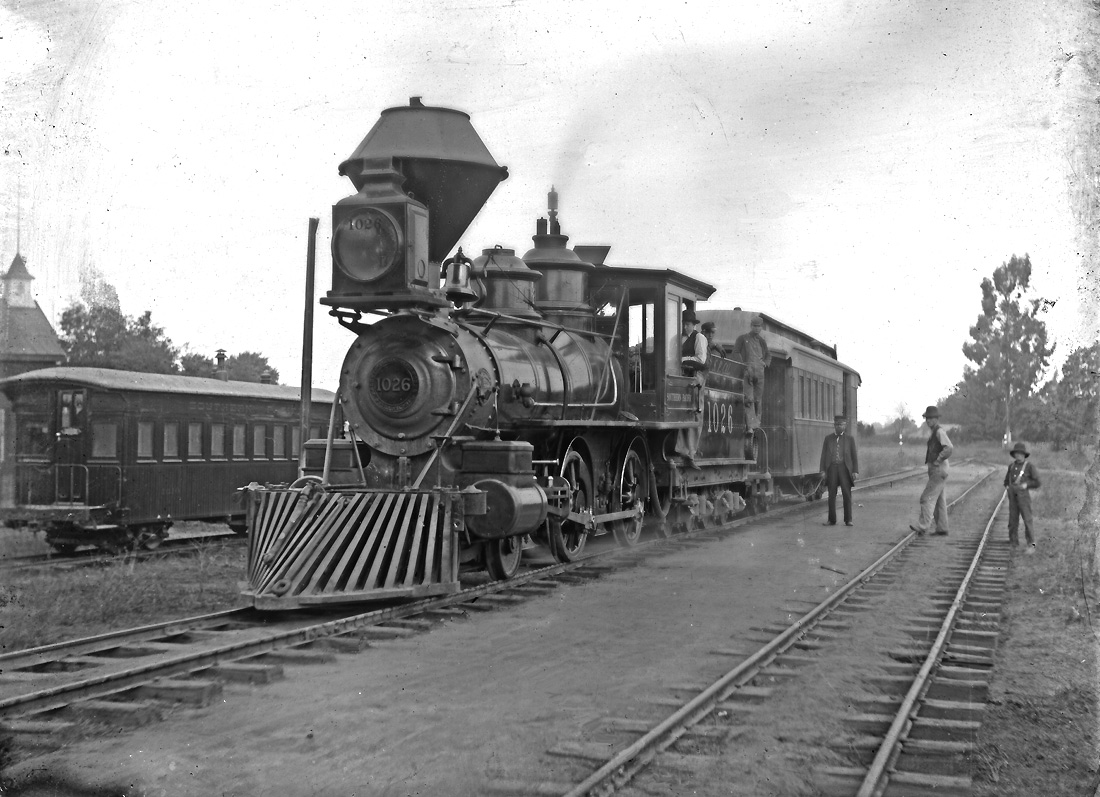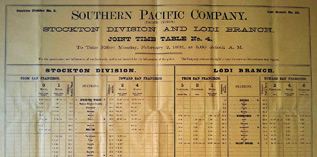
(click image for larger rendition) SP of California #1026, Woodbridge, CA? ca1903-04
Unknown photographer; 4"x5" glass plate negative in Wx4 Collection
|
Part of Wx4's Past Less Traveled series...

If you have perused a copy of Guy Dunscomb’s A Century of Southern Pacific Steam Locomotives, you may recognize a cropped version of the photo from page 362. It portrays S. P. of California’s well-traveled narrow gauge #1026, which at the time of the 1903-4 photo was performing duties on the former San Joaquin & Sierra Nevada Railroad. Our best guess is that the photo was recorded at Woodbridge, where its shops were located. Diebert and Strapac’s Southern Pacific Steam Locomotive Compendium tells us that Baldwin turned out the loco as Oregonian Railroad #8 in August, 1881. Oregonian was completely standard gauge by 1893, and no record seems to exist of the loco finding employment between then and the time that it became an S. P. of California engine on 12-28-1903. As such, it worked less than a year, as the Southern Pacific standard gauged the railroad the next August. Kyle Wyatt disclosed in Arnold Menke’s Compendium Companion that #1026 spent time in 1904 [and 1905?] on the Carson & Colorado without renumbering. He also stated that C. D. Bunker bought the engine on 8-8-06, and that its boiler turned up as riprap along the river near SP's Sacramento Shops in the late 1990’s, leading one to wonder if SP repossessed the engine. The boiler is preserved at CSRM.
During its short life on SJ&SN, #1026 must have been a celebrity. A from-the-cab shot looking back at its tender and train, as well as a Carter Brother's builder's photo of the railroad's swanky coach Ettie, appear in Bruce MacGregor's Birth of California Narrow Gauge, page 525. Another photo of the loco appeared on the front cover of "Western Railroader" Issue #198 (4-1956). Let us know if you are aware of others.
Should you be curious about the line, PacificNG.org has a very thorough writeup on its history. The essentials are that it began building eastward from Brack's Landing towards Woodbridge, Lodi, Lockeford and Valley Springs in early 1882, a task that was completed in 1885. Founder Jacob Brack's namesake landing, located on the Mokelume River's Beaver Slough, only did a so-so business as a rail-water transfer point in early years because the agricultural products that were its mainstay consisted almost exclusively of wheat, which was a boom business for only about six weeks out of the year. Most freight (and passengers) wound up transferring to SP at Lodi, SP's Northern Railway took over the struggling company in 1888 and began diverting much of Brack's Landing business to Stockton. In 1893, SP formally declared its intentions to standard gauge and abandon the now largely moribund portion from Brack's Landing to Woodbridge, but Brack was opposed and still held $22,000 in railroad bonds. He claimed that such a move would make his bonds worthless, because they described a railroad running to his landing. In response, SP simply waited until the bonds expired, then began tearing out the Brack's Landing line in July, 1896 (not 1897 as is usually claimed). Why SP waited until 1904 to widen the gauge is unclear.

(click image for larger rendition) This 1891 SP employee timetable from Tim Zukas's Historical Maps & Timetables page, shows the former SF&SN as the Lodi Branch. Note that regular service west of Woodbridge is non extant, a condition that seems to have predated the onset of SP's tenure. Few SF&SN timetables are known to exist, and the railroad never appeared in the Official Guide.
|